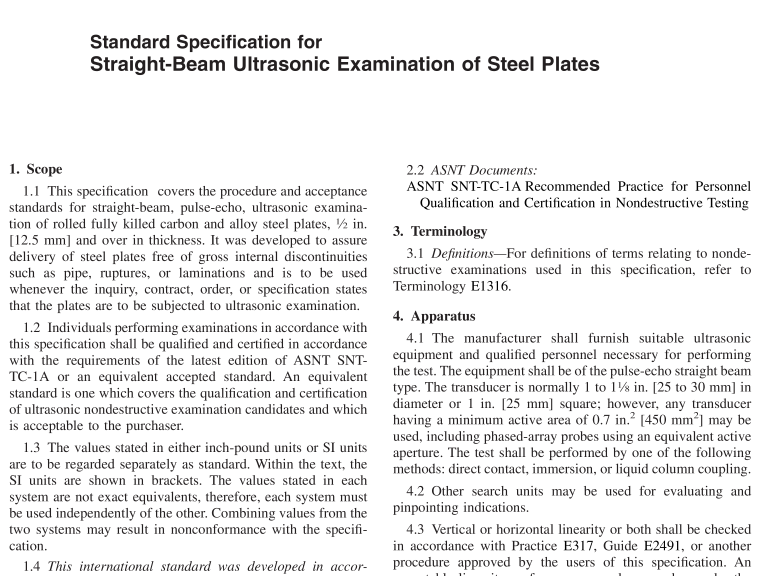ASME SA-435 pdf download

ASME SA-435 pdf download Standard Specification for Straight-Beam Ultrasonic Examination of Steel Plates
1. Scope
1.1 This specification covers the procedure and acceptance standards for straight-beam, pulse-echo, ultrasonic examina- tion of rolled fully killed carbon and alloy steel plates, 1 ⁄ 2 in. [12.5 mm] and over in thickness. It was developed to assure delivery of steel plates free of gross internal discontinuities such as pipe, ruptures, or laminations and is to be used whenever the inquiry, contract, order, or specification states that the plates are to be subjected to ultrasonic examination.
1.2 Individuals performing examinations in accordance with this specification shall be qualified and certified in accordance with the requirements of the latest edition of ASNT SNT- TC-1A or an equivalent accepted standard. An equivalent standard is one which covers the qualification and certification of ultrasonic nondestructive examination candidates and which is acceptable to the purchaser.
1.3 The values stated in either inch-pound units or SI units are to be regarded separately as standard. Within the text, the SI units are shown in brackets. The values stated in each system are not exact equivalents, therefore, each system must be used independently ofthe other. Combining values from the two systems may result in nonconformance with the specifi- cation.
1.4 This international standard was developed in accor- dance with internationally recognized principles on standard- ization established in the Decision on Principles for the Development of International Standards, Guides and Recom- mendations issued by the World Trade Organization Technical Barriers to Trade (TBT) Committee.
2. Referenced Documents
2.1 ASTM Standards: E317 Practice for Evaluating Performance Characteristics of Ultrasonic Pulse-Echo Testing Instruments and Systems without the Use of Electronic Measurement Instruments E1316 Terminology for Nondestructive Examinations E2491 Guide for Evaluating Performance Characteristics of Phased-Array Ultrasonic Testing Instruments and Systems
2.2 ASNT Documents: ASNT SNT-TC-1A Recommended Practice for Personnel Qualification and Certification in Nondestructive Testing
3. Terminology
3.1 Definitions—For definitions of terms relating to nonde- structive examinations used in this specification, refer to Terminology E1316.
4. Apparatus
4.1 The manufacturer shall furnish suitable ultrasonic equipment and qualified personnel necessary for performing the test. The equipment shall be ofthe pulse-echo straight beam type. The transducer is normally 1 to 1 1 ⁄ 8 in. [25 to 30 mm] in diameter or 1 in. [25 mm] square; however, any transducer having a minimum active area of 0.7 in. 2 [450 mm 2 ] may be used, including phased-array probes using an equivalent active aperture. The test shall be performed by one of the following methods: direct contact, immersion, or liquid column coupling.
4.2 Other search units may be used for evaluating and pinpointing indications.
4.3 Vertical or horizontal linearity or both shall be checked in accordance with Practice E317, Guide E2491, or another procedure approved by the users of this specification. An acceptable linearity performance may be agreed upon by the manufacturer and purchaser.
5. Test Conditions
5.1 Conduct the examination in an area free of operations that interfere with proper functioning of the equipment.
5.2 Clean and smooth the plate surface sufficiently to maintain a reference back reflection from the opposite side of the plate at least 50 % of the full scale during scanning.
5.3 The surface of plates inspected by this method may be expected to contain a residue of oil or rust or both. Any specified identification which is removed when grinding to achieve proper surface smoothness shall be restored.
6. Procedure
6.1 Ultrasonic examination shall be made on either major surface of the plate. Acceptance of defects in close proximity may require inspection from the second major surface. Plates ordered in the quenched and tempered condition shall be tested following heat treatment.
6.2 A nominal test frequency of 2 1 ⁄ 4 MHz is recommended. Thickness, grain size, or microstructure of the material and nature of the equipment or method may require a higher or lower test frequency. However, frequencies less than 1 MHz may be used only on agreement with the purchaser.
A clear, easily interpreted A-scan should be produced during the examination. 6.3 Conduct the examination with a test frequency and instrument adjustment that will produce a minimum 50 to a maximum 75 % of full scale reference back reflection from the opposite side of a sound area of the plate.
6.4 Scanning shall be continuous along perpendicular grid lines on nominal 9-in. [225-mm] centers, or at the manufac- turer’s option, shall be continuous along parallel paths, trans- verse to the major plate axis, on nominal 4-in. [100-mm] centers, or shall be continuous along parallel paths parallel to the major plate axis, on 3-in. [75-mm] or smaller centers. A suitable couplant such as water, soluble oil, or glycerin, shall be used. 6.5 Scanning lines shall be measured from the center or one corner of the plate. An additional path shall be scanned within 2 in. [50 mm] of all edges of the plate on the scanning surface.









